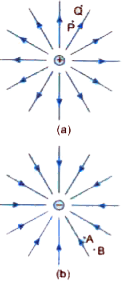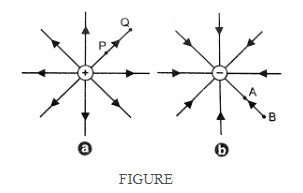Fig (a) and (b) show the field lines of a single positive and negative charges respectively .
Does the kinetic energy of a small negative charge increase or decrease in going from B to A ?

We have seen in part (b) of the question that there is a gain in potential energy of a small -ve charge in going from B to A . Gain in potential energy means loss of kinetic energy . It means that K.E. of a small -ve charge decreases in going from B to A .
Topper's Solved these Questions
- ELECTROSTATIC POTENTIAL AND CAPACITANCE BOOK - U-LIKE SERIESCHAPTER - ELECTROSTATIC POTENTIAL AND CAPACITANCE EXERCISE - LONG ANSWER QUESTIONS-II
13 Videos
- ELECTROSTATIC POTENTIAL AND CAPACITANCE BOOK - U-LIKE SERIESCHAPTER - ELECTROSTATIC POTENTIAL AND CAPACITANCE EXERCISE - SELF ASSESSMENT TEST
1 Videos
- ELECTROSTATIC POTENTIAL AND CAPACITANCE BOOK - U-LIKE SERIESCHAPTER - ELECTROSTATIC POTENTIAL AND CAPACITANCE EXERCISE - SHORT ANSWER QUESTIONS
48 Videos
- ELECTROMAGNETICE INDUCTIONBOOK - U-LIKE SERIESCHAPTER - ELECTROMAGNETICE INDUCTIONEXERCISE - Self Assessment Test Section -D
1 Videos
- EXAMINATION PAPER 2020 (SOLVED)BOOK - U-LIKE SERIESCHAPTER - EXAMINATION PAPER 2020 (SOLVED)EXERCISE - SECTION D
6 Videos
Similar Questions
Fig (a) and (b) show the field lines of a single positive and negative charges respectively .
Give the sign of the potential energy difference of a small negative charge between the points Q and P , A and B .

View SolutionFig (a) and (b) show the field lines of a single positive and negative charges respectively .
Give the sign of the work done by an external agency in moving a small negative charge from B to A .

View Solution
Knowledge Check
Electric lines of force about negative point charge are
ACircular, anticlockwiseBCircular, clockwiseCRadial, inwardsDRadial , outwards
Figure shows the field lines of a point negative charge. In going from B to A, the kinetic energy of a small negative charge will

View SolutionFig (a) and (b) show the field lines of a single positive and negative charges respectively .
Give the sign of the work done by the field in moving a small positive charge from Q to P .

View SolutionFigure shows the field lines of a point negative charge. In going from B to A, the kinetic energy of a small negative charge will

View SolutionFigures (a) and (b) show the field lines of a positive and negative point charge respectively.

(a) Give the signs of the potential difference VP−VQ,VB−VA.
(b) Give the sign of the potential energy difference of a small negative charge between the points Q and P, A and B.
(c) Give the sign of the work done by the field in moving a small positive charge from Q to P.
(d) Give the sign of the work done by the external agency in moving a small negative charge from B to A.
(e) Does the kinetic energy of a small negative charge increase or decrease in going from B to A?
View SolutionFigure (a) and (b) show the field lines of a positive and negative point charge respectively.

(a) Give the signs of the potential difference . Vp−VQ,VB−VA
(b) Give the sign of the potential energy difference if a small negative charge is moved from points Q to P from point A to B.
(c) Give the sign of the work done by the field in moving a small positive charge from Q to P.
( d) Give the sign of the work done by the external agency in moving a samall negative charge from B to A .
(e ) Does the kinetic energy of a small negative charge increase or decrease in going from B to A ?
View SolutionFigures (a) and (b) show the field lines of a positive and negative point charge respectively

(a) Give the signs of the potential difference VP−VQ,VB–VA.
(b) Give the sign of the potential energy difference of a small negative charge between the points Q and P, A and B.
(c) Give the sign of the work done by the field in moving a small positive charge from Q to P.
(d) Give the sign of the work done by the external agency in moving a small negative charge from B to A.
(e) Does the kinetic energy of a small negative charge increase or decrease in going from B to A?
View SolutionFig (a) and (b) show the field lines of a single positive and negative charges respectively .
Give the signs of the potential difference : VP−VQ,VB−VA

View Solution
